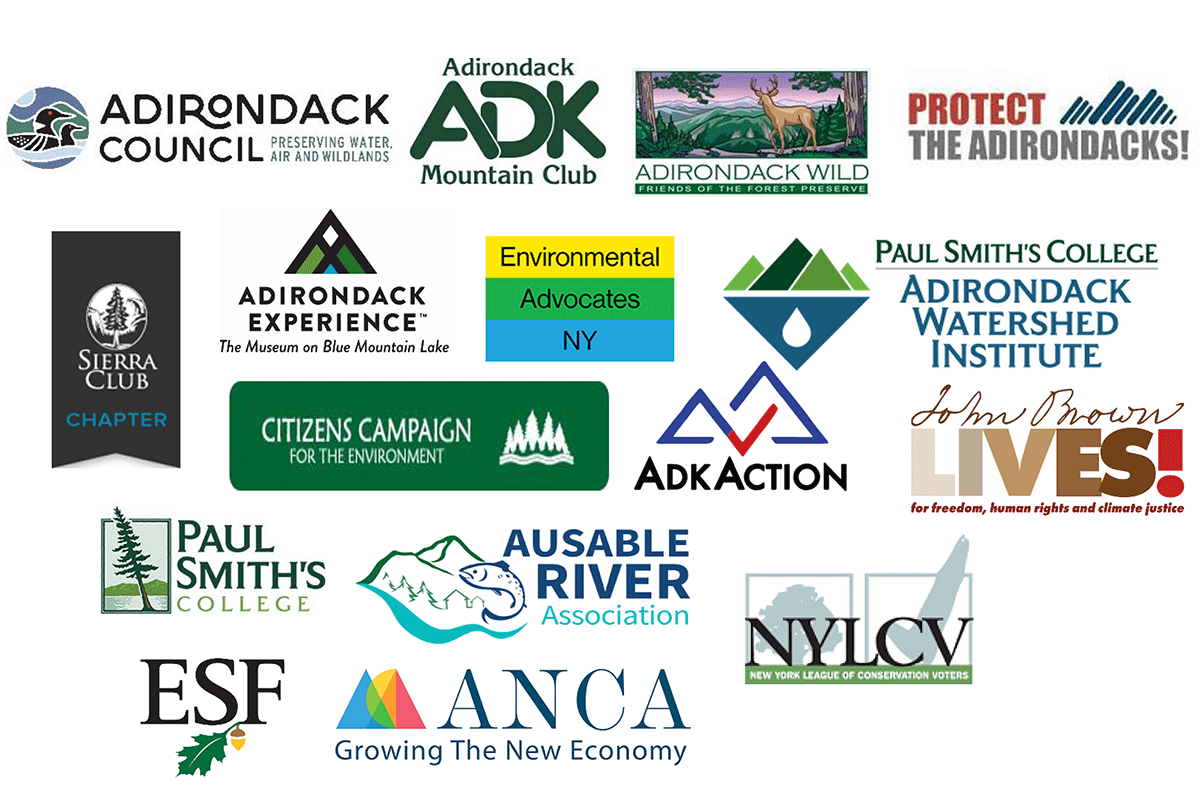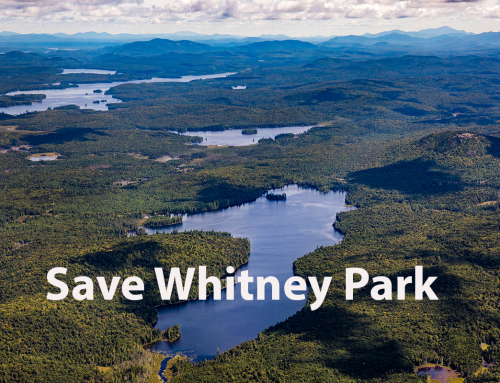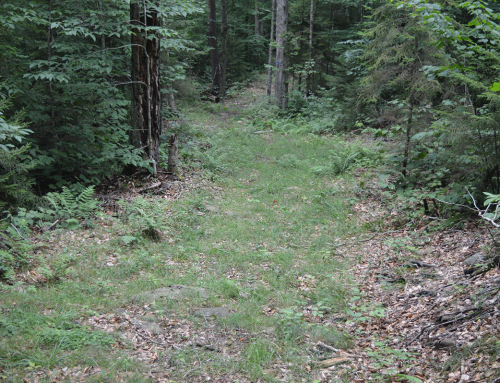2024-25 NYS Budget Priorities for the Adirondack Park.
The Honorable Kathy Hochul
Governor of New York State
NYS State Capitol Building
Albany, NY 12224
Dear Governor Hochul,
The Adirondack Park today faces many challenges that were unforeseen or unimagined as recently as a decade ago. These challenges include the impacts of global climate change, road salt pollution, rapidly changing technological advances, invasive species impacts, and the pressures on Adirondack communities from the vacation-home and short-term-rental marketplace. Current legal protections and the regulatory and management programs put in place 50 years ago are outdated and will not sustain the long-term protection of the iconic wild lands of the Park and put at risk the viability andprosperity of Adirondack communities in the future. New York stands at a crossroads in its management of the Adirondack Park. The common denominator in all of the challenges is greater investment in the Forest Preserve and rural communities of the Adirondack Park.
Your new Executive Budget will set out your priorities for the Adirondack Park and will shape how theNorth Country will fare in the coming year. We have always believed that a healthy environment andvigorous economy are not mutually exclusive, but go hand-in-hand. Bold, strategic investments in thepreservation of the Adirondack Park are essential to the regional economy and vitality of its small ruralcommunities. As you develop your Executive Budget proposal for the 2024-25 fiscal year, please consider the following list of critical investments as core parts of your Adirondack Park agenda:
- $400 million for the Environmental Protection Fund (EPF). The EPF supports many vital programs for the Adirondacks, including:
- $50 million for open space protection and land conservation, including $3.07 million for the Land Trust Alliance Conservation Partnership and at least $1.5 million for their Conservation Easement Programs.
- $50 million for State Land Stewardship split between the DEC and OPRHP, including$10 million for Adirondack Visitor Safety and Wilderness Protection, $2 million for Parksand Trails Grants Program, $1 million for a long-required and long-overdue Carrying Capacity Study on the Saranac Chain of Lakes, and $1 million for Wildlife Research on State Lands, and $3 million this year for the Survey of Climate Change andAdirondack Lakes Ecosystems (SCALE).
- $2.1 million for the Timbuctoo Summer Climate and Careers Institute.
- $1 million for Visitor Centers with $250,000 each for Paul Smith’s Visitor Interpretive Center (VIC), the SUNY Environmental Science and Forestry (ESF) Adirondack Interpretive Center (AIC), the ADK High Peaks Information Center, and the CatskillsVisitor
- $20 million for invasive species prevention and eradication programs, including $500,000 for Cornell’s New York State Hemlock Initiative.
- $600,000 for research and monitoring in the Forest Preserve: the Adirondack Watershed Institute at Paul Smith’s College, the Atmospheric Science and Research Center (ASRC) Whiteface Mountain Field Station, and Cary Institute for Ecosystem Studies.
- Continued and increased funding for Smart Growth.
- Allocating $600 million for the Clean Water Infrastructure Act (CWIA), to assist rural communities with gap-closing grants that will support clean water, affordable housing ,and business.
- $420,000 for the Adirondack Diversity Initiative (ADI).
- $2 million for the Adirondack Experience (ADKX) exhibit on the African American Experience in the Adirondacks.
- Invest in the implementation of the Adirondack Park Road Salt Reduction Task Force final report recommendations.
$400 million Environmental Protection Fund (EPF)
With your leadership, the EPF grew to $400 million two years ago. With that increase came notable investments in Adirondack Park open space protection, state land stewardship, climate change mitigation and adaptation and more. This year, we can’t go backwards and urge funding the EPF at aminimum of $400 million as we work towards a goal of $500 million over the long term. The following EPF categories are of particular importance to the Adirondack Park and its communities:
- $50 million for Open Space Protection: We applaud the public’s overwhelming support and passage of the Clean Air, Clean Water, and Green Jobs Bond Act. Bond Act funding was always intended to be additive to foundational programs such as the open space protection line of the EPF. The 30 by 30 Act prioritizes funding for open space protection across New York to meet thestate’s ambitious goal of protecting 30% of our lands and waters by Future years will requiremuch greater funding for land protection from the EPF and other sources. Open space protection for ecologically significant Adirondack properties threatened with subdivision and development,such as the 36,000-acre Whitney Park in Long Lake, depends on the monies allocated to the Open Space account in the EPF. We urge you to fund the Open Space account at $50 million this year.
- $50 million for State Lands Stewardship: The Forest Preserve has suffered from chronic More investment will support good paying jobs and promote tourism and quality of life benefits for the communities that serve as gateways to these wildland resources.
- Forest Preserve Stewardship: Thank you for working with the Legislature to approve $8 million for an Adirondack and Catskill Visitor Safety and Wilderness Protection subcategory last year, for the preservation and care of the “forever wild” Forest Preserve. Our great Wilderness areas, such as the High Peaks Wilderness, are key attractions in the Adirondack Park, providing an immeasurable benefit to the residents of this We urge you to increase funding dedicated to Adirondack and Catskill visitor safety & wilderness protection to $10 million this year.
- $1 million to fund a Carrying Capacity Study on the Saranac Chain of Lakes: This study has been required under state law for decades, but never completed. This study is needed now more than ever due to increased development pressures around the Saranac Chain of Lakes.
- $1 million to fund Wildlife Research on State Lands. Wildlife research in New York is driven heavily for game species by hunting license revenues. Forest Preserve planners have little information about wildlife populations on State lands.
- $20 million for Invasive Species. We support expansion of the Invasive Species Accountto $20 million this year, split evenly between prevention and interdiction and eradication. These funds assist local governments and many entities across New York in their work to educate the public about invasive species and stop their spread. The Adirondack Park is the only place in New York with a large number of waterbodies that remain free of invasive species infestations and we need to keep these waters free and pure. The New York State Hemlock Initiative works in the Forest Preserve and across the state to protect Hemlock Forests from Hemlock Woolly Adelgid.
- $1 million for Adirondack Park and Catskill Park Visitor Centers: We support funding Visitor Centers in the Forest Preserve at $1 million, with $250,000 each for Paul Smith’s VIC, the SUNY ESF AIC, the ADK High Peaks Information Center, and the Catskills Visitor Center. These facilities are strategically located and attract visitors traveling to popular destinations. Continued funding of these centers, which rely heavily on private fundraising, is critical as they serve to protect the Forest Preserve, keep recreators safe, educate youth and the public, and highlight community assets.
- Vital Research Institutions: We support $200,000 each for the following institutions for researchand monitoring: the Adirondack Watershed Institute at Paul Smith’s College to help fund the only state-certified biological laboratory in the Adirondacks and long-term water quality research, the ASRC Whiteface Mountain Field Station for Trace Gas Monitoring and Cloud Collection and Analysis to continue at the facility, and Cary Institute for Ecosystem Studies for Forest Preserve research and collaboration that supports land management and community engagement.
Survey of Climate Change and Adirondack Lakes Ecosystems (SCALE)
The water quality of Adirondack lakes and ponds reflect the Park’s ecological, economic and climate destiny. A consortium of non-profit partners and academic institutions have designed a three-year water quality Survey of Climate Change and Adirondack Lake Ecosystems which has great potential to guideour state’s climate policy. Researchers will examine how climate change impacts baseline conditions ofwaterbodies, explore the relationships between climate change and harmful algae blooms, food webs, and mercury bioaccumulation. This data will inform future climate policymaking and guide strategic investment in greenhouse gas reduction and climate resiliency.
You worked with the legislature to provide an initial $500,000 in the FY 22-23 budget, and an additional $2 million in the FY 23-24 budget. The initial $500,000 has funded a pilot survey that was carried out thissummer. The results of the pilot will shape the full survey when it is conducted. The $2 million approved last year will assist with the early phases of the full survey, but additional funding is needed.
We request a $3 million allocation for a Survey of Climate change and Adirondack Lakes Ecosystems this year, with funding dedicated to the core team of SCALE consortium partners – Cornell College of Agriculture and Life Sciences (CALS), Rensselaer Polytechnic Institute (RPI), the Ausable River Association and other academic partners.
Preserving Clean Water and Promoting Community Vibrancy
The Adirondack Park has aging clean water and wastewater infrastructure. The impacts are far- reaching – from closed beaches to impaired trout streams to harmful algae blooms. Small Adirondack communities host large seasonal influxes of visitors, including vacation rentals that stress these aging systems further, especially impacting the shores of our Adirondack lakes.
Investments in water infrastructure constitute one of the most pivotal investments the state can make in protecting Adirondack waters while promoting new business and affordable housing in Adirondack Park hamlets. Since 2016, New York State (NYS) has invested close to $100 million in grants for clean water infrastructure projects for communities in the Adirondack Park region, but the need is far greater, currently exceeding $200 million in a backlog of wastewater treatment plants and sewer system projects alone in over a dozen communities.
Clean water infrastructure grants are essential for these communities in the Adirondacks with lower median household incomes and low user bases to cover the local cost share. We request $600 million for the Clean Water Infrastructure Act (CWIA) this year to help not only our state-wide needs but also address these critical needs in the Adirondack region. We also encourage federal Bipartisan Infrastructure Law clean water grants and newly established NYS Bond Act funding to supplement these needs so all projects in the Adirondacks can be affordable for these rural and hardship local communities.
Furthermore, greater investment and eligibility is needed for the NYS State Septic Replacement Fund to assist residents who have septic systems on Adirondack Lakes. The vast majority of wastewater controls surrounding these water bodies are decentralized and managed through homeowner’s septic systems. Many of these systems are outdated and failing, costing tens of thousands of dollars to replace. Setting aside additional funds through the Clean Water Infrastructure Act for the Septic Replacement Fund, which can provide up to 50% of remediation costs, will go a long way to help Adirondack lakes remain healthy and for those with harmful algae blooms combat that problem.
Fostering Diversity, Equity, Inclusion, and Climate Justice for the Adirondacks
We all must do more to ensure that all New Yorkers have the opportunity to enjoy and benefit from the precious resources of the Adirondack Park. The Adirondacks can be a place of respite, a critical resource in fighting climate change, and a place of opportunity for those pursuing green jobs.
The fight for climate, environmental, and social justice demands that as we fight climate change, we better connect the Adirondack Park with communities living on the frontlines of climate change impacts across the state. We celebrate that New York’s Adirondack Park was a cradle of the early fight for Black suffrage. In that same spirit of opportunity, the Timbuctoo Climate Science and Careers Institute introduces high school students to a broad spectrum of green job opportunities, fostering the next generation of environmental stewards and climate advocates. The first year of this program was a great success, with the SUNY school of Environmental Science and Forestry and CUNY Medgar Evers hosting 41 students from the Bronx, Queens, and Brooklyn. The program sees an opportunity to grow stronger in the coming year,while working within its existing budget framework. We encourage you to fund the Timbuctoo Summer Climate and Careers Institute at $2.1 million once again this year.
The Adirondack Diversity Initiative (ADI) works to make the Adirondack region more welcoming and inclusive to all New Yorkers. ADI currently benefits from a $420,000 appropriation in the Aid to Localities Budget. Along with many other ongoing efforts, ADI provides critical anti-bias training to EnvironmentalConservation Officers, and that work continues to expand and grow stronger. A new Micro-Credential focused on welcoming and belonging will launch in January 2024, and an ADI symposium will be hosted every other year. We support the Adirondack North Country Association’s proposal to continue itsallocation in this year’s budget, in response to the program’s growing impact and effectiveness.
The Adirondack Experience (ADKX) plans to create a major permanent exhibition dedicated to the untold story of African Americans and their experiences, past and present, in the Adirondacks. The 2,500-square-foot African American Experience in the Adirondacks exhibition will include hands-on, interactive features to engage 21st-century audiences. The exhibition will provide a focus for encouraging Black, Indigenous, and People of Color (BIPOC) communities to visit the region. We urge your support of this $2 million project as it works towards a 2026 launch.
Implementation of Adirondack Road Salt Reduction Task Force Report
With the release of the Adirondack Road Salt Reduction Task Force Report, New York State now has documented the solutions and strategies needed to reduce road salt pollution. This is an important first step. But to fulfill the recommendations put forward by the task force, New York now requires a plan of action andtimeline, a mechanism for ensuring accountability to fulfilling that plan, and committed funding forimplementation. To do this, we propose the following actions in the next year to reduce road salt pollution:
- Establish an inter-agency and independent New York State Road Salt Reduction Advisory Council to guide the implementation of these recommendations.
- With the input of a New York State Road Salt Reduction Advisory council, create a year-by- year plan of action that can include tangible frame works to help design, frame, fund, and oversee the implementation of new and scaled recommended programs. As part of this plan of action, we urge you to establish a New York State water quality standard for chloride.
- Dedicate funding towards implementation of the task force Investments in road salt reduction have proven effective at dramatically reducing pressures on local winter road maintenance budgets. Eligibility for grant funds from the NYSDEC Road Salt Storage Facility program and the Water Infrastructure Improvement Act should be expanded to include equipment for salt reduction best management practices.
Establishing a New York State Civilian Climate Corps
The Biden Administration recently took executive action to launch the Civilian Climate Corps (CCC),which will train young people in clean energy, conservation, and climate resilience skills, create good-paying jobs and tackle the climate crisis. The CCC is a workforce training and service initiative that will ensure more young people have access to the skills-based training necessary for good-paying careers in the clean energy and climate resilience economy. As a core tenet of the program, the CCC will center on equity and environmental justice, leveraging the talents of all members of our society. New York has an opportunity in a challenging budget cycle to leverage this initiative to accelerate our green economy and bolster our capacity to steward the Adirondack Park. Please propose to establish and fund the NewYork State CCC this year.
Conclusion
The organizations listed above have outlined a powerful agenda that we urge you to embrace. This agenda meets the critical needs facing the environment and small rural communities of the Adirondack Park. This is an ambitious agenda that will not only support action in the next fiscal year, but creates a foundation to continue to build on in future years. We stand ready to help in any way possible to help you advance these policies and programs. Thank you very much for your stalwart support for the Adirondack Park.
Sincerely,
Raul J. Aguirre, Executive Director, Adirondack Council
Sawyer Bailey, Executive Director, AdkAction
Michael Barrett, Executive Director, Adirondack Mountain Club
Peter Bauer, Executive Director, Protect the Adirondacks
Elizabeth Cooper, Executive Director, Adirondack North Country Association
Roger Downs, Director of Conservation, Sierra Club Atlantic Chapter
David Gibson, Managing Partner, Adirondack Wild: Friends of the Forest Preserve
Rob Hayes, Director of Clean Water, Environmental Advocates NY
Paul B. Hai, Associate Director, SUNY ESF Adirondack Ecological Center
David Kahn, Executive Director, Adirondack Experience
Dan Kelting, Interim College President, Paul Smith’s College
Patrick McClellan, Policy Director, New York League of Conservation Voters
Brian Smith, Associate Executive Director, Citizens Campaign for the Environment
Zoë Smith, Executive Director, Adirondack Watershed Institute
Martha Swan, Founder and Executive Director, John Brown Lives!
Kelley Tucker, Executive Director, Ausable River Association
CC:
Kathryn Garcia, Director of State Operations, Executive Chamber
John O’Leary, Deputy Secretary for Energy and the Environment
Ashley Dougherty, Assistant Secretary for the Environment
Nivardo Lopez, Deputy Secretary for Transportation
Blake Washington, Budget Director, NYSDOB
Basil Seggos, Commissioner, NYSDEC
Barbara Rice, Executive Director, NYSAPA
Erik Kulleseid, Commissioner, NYSOPRHP
Marie Therese Dominguez, NYSDOT






